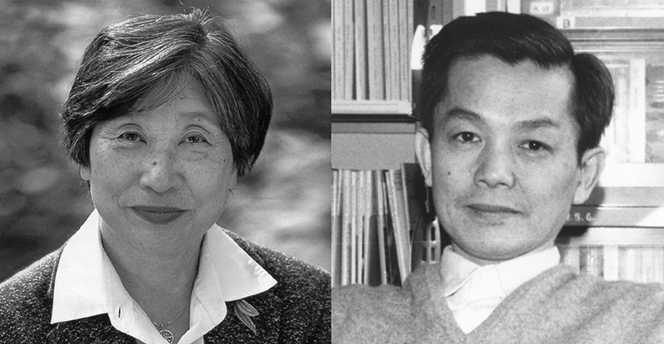The 6th Tsuneko & Reiji Okazaki Award Winner
Clifford P. Brangwynne
June K. Wu ’92 Professor of
Chemical & Biological Engineering, Princeton University
Investigator, Howard Hughes Medical Institute

Professors Tsuneko and Reiji Okazaki and the Okazaki Fragment
In 1953, using data generated by Rosalind Franklin, James Watson and Francis Crick elucidated the double-helical structure of DNA, the molecule responsible for storing genetic information. Their work was soon followed by numerous discoveries related to the structure and replication of DNA, including the identification of DNA polymerase, which is the enzyme required for the replication of DNA, and proof of the semiconservative replication of DNA, wherein the two strands of DNA are replicated separately to yield two new double strands, each composed of an original strand and a newly synthesized strand. The Okazaki fragment was discovered during these exciting early years of molecular biology.
The nucleotides in the two strands of the DNA double helix are oriented in opposite directions (known as the 5’→3’ and 3’→5’ directions). When DNA is replicated within a dividing cell, the two original or parental strands are separated and the simultaneous elongation of the two daughter strands is apparent at the replication site on the parental DNA. This observation led to the inference that both daughter strands grow continuously, with the direction of synthesis being 5'→3' on one daughter strand and 3'→5' on the other. However, such a mechanism of continuous strand growth conflicted with observations made in vitro. The DNA polymerase that had been shown to be responsible for the replication of DNA only catalyzes the synthesis of DNA the 5’→3’ direction in vitro and, indeed, no enzymatic reaction catalyzing the 3’→5’ synthesis of DNA has been identified to date.
In the late 1950’s and early 1960’s, molecular biologists were unable to explain how two daughter strands could grow, in opposite directions, from a single replication point in vivo.
In 1963, Tsuneko and Reiji Okazaki started their research at Nagoya University, and they decided to try to unravel this mystery of DNA replication. They realized that semiconservative replication could be explained if daughter strands of DNA were synthesized in vivo by a discontinuous mechanism. Looking closely at the replication point, they examined whether the daughter strand that was growing in the 3’→5’ direction (known as the “lagging” strand) might be synthesized as short fragments in the 5’→3’ direction, namely, in the direction opposite to the actual direction of extension of the newly synthesized daughter DNA. If such were the case, the daughter strand could grow longer when these short fragments were linked together.
In order to prove their hypothesis, the Okazaki group performed painstaking experiments and found that short fragments of DNA, consisting of 1,000 to 2,000 base pairs, were being synthesized in replicating cells[1]. The Okazaki group discovered, moreover, that such short fragments accumulated upon impairment of the function of DNA ligase, the enzyme that links together fragments of DNA. By contrast, in the presence of DNA ligase, long strands of DNA were generated from short fragments that were linked together by the ligase[2].
The results obtained by the Okazaki group led to proposal of the model of discontinuous growth of replicating strands of DNA, wherein DNA replication on the lagging strand occurs via formation of short DNA fragments that are subsequently linked together. These short fragments of DNA were named "Okazaki pieces" by Rollin Hotchkiss in 1968 at the Cold Spring Harbor Symposium on the Replication of DNA in Micro-organisms[3].
The concept of discontinuous growth of replicating DNA gradually gained acceptance but the primers necessary for initiation of the replication process on the lagging strand remained to be identified.
Reiji Okazaki passed away prematurely in August 1975, but his wife Tsuneko and their colleagues continued to study the problem and identified the RNA primer responsible for replication[4]. This was the final piece of the puzzle, providing evidence for the model proposed by Tsuneko and Reiji Okazaki.
Not only did the research by the Tsuneko and Reiji Okazaki lead to groundbreaking discoveries in the field of molecular biology but their persistence has served as a model and inspiration for subsequent generations of researchers, who continue to test their own hypotheses and seek the truth in many areas of scientific endeavor.
- Okazaki R, Okazaki T, Sakabe K, Sugimoto K, Sugino A (1968) Mechanism of DNA chain growth, I. Possible discontinuity and unusual secondary structure of newly synthesized chains. Proc Natl Acad Sci USA 59: 598–605.
- Sugimoto K, Okazaki T, Okazaki R (1968) Mechanism of DNA chain growth, II. Accumulation of newly synthesized short chains in E. coli infected with ligase-defective T4 phages. Proc Natl Acad Sci USA 60: 1356–1362.
- Hotchkiss RD (1968) Metabolism and growth of gene substance: 1968. Cold Spring Har Sym Quant Biol 33: 857-870.
- Okazaki T, Kurosawa Y, Ogawa T, Seki Y, Shinozaki K, Hirose S, Fujiyama A, Kohara Y, Machida Y, Tamanoi F, Hozumi T (1979) Structure and metabolism of RNA primer in discontinuous replication of prokaryotic DNA. Cold Spring Har Sym Quant Biol 43: 203-219.